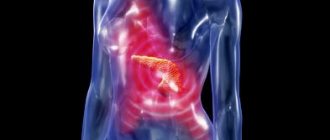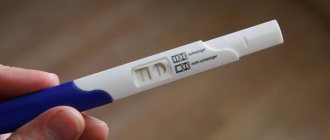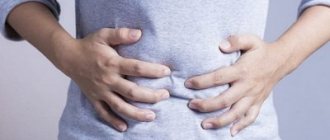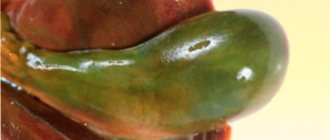What is the most common cause of abdominal pain? When does an aching stomach indicate serious illnesses? When should you visit an endocrinologist? What methods are effective for relieving abdominal pain?
Stomach pain can be caused by various factors. The cause may be, among other things, gastritis, gastrointestinal infections or peptic ulcers. Sometimes, however, there is no organic cause in the gastrointestinal tract. In this case, the condition is called dyspepsia or functional dyspepsia.
Abdominal pain is sometimes not related to the gastrointestinal tract, for example, it is caused by stress or neurological disorders.
Causes of abdominal pain - what does abdominal pain mean?
The content of the article
There are several main causes of abdominal pain:
- Gastritis
. The most common cause of gastritis is infection with the bacterium Helicobacter pylori. This infection is very common. In addition to gastritis, infection with this bacterium is also a risk factor for stomach ulcers and cancer. Gastritis is often asymptomatic, but can also cause abdominal pain. - Hemorrhagic gastropathy.
Another common cause of abdominal pain is acute hemorrhagic gastropathy. This is a type of gastritis with erosions. Abdominal pain occurs after excessive use of painkillers and alcohol, as well as as a result of stress and serious injury. - Foodborne infections
. May also cause pain in the stomach area. Then the pain accompanies infectious diarrhea. The etiological factor of such diarrhea is viruses, bacteria or bacterial toxins. - Dysbacteriosis
. After long-term use of an antibiotic, so-called post-antibiotic diarrhea usually occurs, which consists of a disturbance in the composition of the intestinal bacterial flora. - Peptic ulcer disease
. This condition also produces characteristic pain. The main cause of stomach ulcers is H. pylori infection. Less commonly, ulcers can form as a result of taking non-steroidal anti-inflammatory drugs and steroids. - Dyspepsia in pregnant women
. Dyspepsia, including abdominal pain, is a common complaint among pregnant women. Due to the anatomical changes that occur in a woman's body, heartburn is also a common problem.
Often the cause of ailments mistakenly taken for abdominal pain is pressure on the sensory nerves, for example, with discopathy of the thoracic spine. Then the abdominal pain may be associated with back pain.
Causes
The human esophagus consists of mucous, submucosal, muscular and adventitial membranes. Injury or dysfunction of one of these structures can cause severe pain, nausea and other unpleasant symptoms. Gastroenterologists identify 7 main factors that can lead to pain.
Reflux esophagitis
Pain may occur due to the patient having reflux esophagitis. This is an inflammatory process that is caused by the action of gastric juice on the mucous membrane of the esophageal tube. This problem arises in patients suffering from gastroesophageal reflux and functional disorders of the digestive system. In this case, the esophagus can hurt even at rest.
Important: Patients may also experience additional symptoms, which should definitely be taken into account. A person may suffer from heartburn, dysphagia and other signs of inflammation.
Peptic esophagitis
This disease causes pain even when swallowing liquids, soft foods and saliva. The nature of the pain syndrome and its intensification can be affected by the food taken and the position of the patient’s body. The pain is very persistent and is localized in the retrosternal region or in the area of the xiphoid process. Pain can radiate to other parts of the body:
- back;
- neck;
- upper part of the esophageal tube;
- rib cage;
- interscapular region;
- collarbone;
- jaw and more.
Important: The sensations are often confused with coronary pain. The difference is that pain in the esophagus with peptic esophagitis does not depend on physical activity and tension. Checking for heart pain is very simple. If after using nitroglycerin the pain in the esophagus does not subside, then the cause is another disorder.
Foreign bodies in the esophagus
In some cases, cartilage and bones of poultry and fish get stuck inside the esophagus. Also, quite often, surgeons have to remove coins, needles, nails, pins, buttons, paper clips and other small objects that have gotten inside from the esophagus.
- Pain when swallowing deeply, on the side of the neck, whoever had this, please come in!!!
If there is a foreign body inside, the patient experiences increased salivation, and pain in the chest area intensifies when swallowing saliva or liquid. The patient may feel a lump that creates discomfort in a certain part of the esophagus. Over time, symptoms such as fever, dysphagia, deterioration of the patient’s health and condition, and even purulent mediastinitis may occur.
Important: Over time, a foreign body can lead to complications, regardless of how long ago the object entered the esophagus and how long it remains motionless in it.
Burns
Burns of the esophagus occur in two cases. In the first, the cause is the accidental ingestion of caustic chemicals, alkalis and acids into the esophagus. In the second case, the reason is that the patient tried to commit suicide and committed suicide using caustic substances.
With burns of the esophagus, the patient experiences pain not only when swallowing, but also immediately after toxic substances enter the body. The pain is localized not only in the esophagus, but also in the larynx, oral cavity and stomach. The most dangerous thing is what complications a burn of the esophagus has.
Hernia
If the hernia is extensive, the pain may radiate to the spine. A clear sign of pain in the esophagus due to hernias is a weakening of the symptom in the upright position of the patient's torso and the absence of a reaction when taking nitroglycerin.
Diseases of the esophagus
Most often, pain in the esophagus is caused by tumor and neuromuscular diseases of the esophageal tube. In addition to the sensation of pain during swallowing, a person is tormented by sudden pain in the form of a “crisis”. The pain is very intense, and is characterized by the fact that it often radiates up the esophagus, into the back and neck. Such a crisis can last from one minute to several hours in a row.
With achalasia cardia, a crisis usually occurs once every 1-3 months. Pain that occurs when swallowing food or saliva occurs in almost every patient with this disease. Pain in the esophagus when swallowing usually has the following characteristics: acute, sharp pain of a cutting nature in the area of the xiphoid process. Characteristic features of such pain are also the feeling that some object is blocking the passage of food and the esophagus is full.
If a person has a tumor of the esophagus, discomfort when swallowing is rare. However, malignant neoplasms in some cases still lead to pain.
Damage to the esophagus
Damage to the esophagus can be internal or external. Internal, closed injuries are factors that affect the mucous membrane of the esophageal tube. External or open injuries occur from penetrating wounds to the chest or throat.
In addition to injury to the esophagus when swallowing foreign bodies, damage often manifests itself in bedsores of the walls. Also, damage that causes pain when swallowing in the esophagus often occurs, such as perforation of the walls of the esophageal tube. It occurs due to the following diseases:
- Why do my knees hurt after running? What to do if pain occurs when running - some effective tips
- tumors;
- chemical burns;
- peptic ulcer.
Important: Pain occurs spontaneously and for a variety of reasons when swallowing in the esophagus. The main thing is to determine what other concomitant symptoms the patient has. It is this factor that can often indicate the cause of the pain syndrome.
Symptoms of abdominal pain - when to contact a gastroenterologist?
Symptoms of abdominal pain
You need to make an appointment with a gastroenterologist if the place where you feel abdominal pain is the upper abdomen, that is, the area under the lower edge of the sternum. Pain in this area may also indicate pathology located in other organs, for example, in the duodenum, intestines, or pancreas.
Pain can be of different natures. With stomach and duodenal ulcers, the pain is burning. She is strong and persistent, but does not interfere with her main activities. Stomach pain occurs at certain times, such as at night or early in the morning. It most often occurs on an empty stomach, a few hours after eating, and decreases after eating or taking antacids.
On the other hand, when a gastric ulcer perforates, patients experience very severe stabbing pain in the abdomen, reminiscent of a knife prick.
In the case of indigestion, that is, dyspepsia, stomach pain is accompanied by pressure in the stomach, a feeling of fullness and nausea. Heartburn, belching and flatulence are also common. Symptoms often appear, mainly after eating.
Symptoms of a foodborne infection usually appear several hours to several days after exposure. The predominant symptom is diarrhea, but gastrointestinal pain and vomiting may also occur.
Get emergency medical help if abdominal pain is accompanied by symptoms such as:
- significant weight loss in a short time;
- abdominal pain that interferes with normal functioning or, for example, sleep;
- gastrointestinal bleeding, manifested as vomiting blood or bloody stools;
- difficulty swallowing;
- palpable swelling in the upper abdomen;
- jaundice;
- signs of severe dehydration such as fainting.
Clinical picture of pain
Additional manifestations of pain when swallowing foods can indicate the cause of the discomfort. However, signs appear already in the later stages. Therefore, you need to pay attention to the main additional symptoms accompanying pain:
- attacks of nausea;
- vomit;
- regurgitation of undigested food;
- heartburn;
- general malaise.
If there is a foreign body in the esophagus, a person becomes weak. The skin becomes pale due to internal trauma. Other signs of the disease include decreased appetite, weight loss and frequent bloating.
If a patient has a hernia, pain occurs when swallowing saliva. An unpleasant sensation spreads to the ear. To alleviate the condition, the body independently makes a muscle spasm, which causes belching or vomiting.
Diagnosis of stomach pain - what tests should be performed?
When diagnosing abdominal pain, a carefully collected medical history is important. The primary diagnosis is made by when symptoms continue, when they occur, and then when they disappear. The rhythm of bowel movements and possible changes in the appearance of the stool are important. You should also tell your doctor about the warning symptoms mentioned earlier.
A blood test, including a complete blood count, may provide some information about gastrointestinal bleeding or nutritional deficiencies.
It is important to check for H. pylori infection. For this purpose, blood tests, stool tests, or a sample taken during a gastroscopy are most often performed. Gastroscopy is a key method for diagnosing peptic ulcers, as well as some inflammations of the gastric mucosa.
In case of abdominal pain, imaging tests, primarily ultrasound, are mandatory. They allow you to confirm or exclude, for example, gallstones or kidney stones. If symptoms do not go away and all organic diseases of the gastrointestinal tract are excluded, functional diseases of the digestive system, which can cause stomach pain, should be diagnosed. These include, for example, pain in the epigastrium.
Diagnosis of functional disorders is difficult, since during their course nervous pain in the stomach is possible. Therefore, a consultation with a psychiatrist may also be required.
Stomach pain - treatment
Treatment for stomach pain depends on the underlying cause. In the case of an active H. pylori infection, it is necessary to kill the bacteria using a combination of antibiotics and proton pump inhibitors (PPIs). The neutralizing effect of PPIs is also used in the treatment of peptic ulcers.
People with peptic ulcers or inflammation of the gastric mucosa are not recommended to use non-steroidal anti-inflammatory drugs such as ibuprofen, diclofenac, ketoprofen and others. They can worsen symptoms and add new ones due to side effects.
On the other hand, in case of pain, paracetamol and diastolic drugs, for example, drotaverine drugs, can be used.
In the treatment of functional dyspepsia, prokinetic drugs that improve the functioning of the digestive system may be useful. Because some cases of abdominal pain can be caused by stress, the help of a therapist may be needed. Antidepressants such as amitriptyline are used to treat such conditions.
Stomach sucking and gastroesophageal reflux disease
Gastroesophageal reflux disease is another common cause of a burning and sucking sensation in the stomach.
Gastroesophageal reflux disease is a set of typical symptoms caused by the release of stomach contents into the esophagus. The problem is related to dysfunction of the lower esophageal sphincter, a muscle that is supposed to prevent regurgitation of stomach contents into the esophagus.
Reflux often develops in obese people taking medications - contraceptives, nitrites, calcium channel blockers, methylxanthines, anticholinergics.
Main symptoms of GER:
- heartburn (burning in the stomach);
- empty and frequent sucking;
- nausea;
- abdominal pain.
Hoarseness and dry cough may also occur.
Home remedies for stomach pain
Home Remedies for Stomach Pain
Self-monitoring is very important when treating stomach pain. You should eat small portions and monitor how your stomach reacts to certain foods. Excluding or including certain ingredients for several days helps with this.
Anyone with peptic ulcers, gastritis or functional disorders should avoid smoking, drinking alcohol and drinking coffee. Coffee does not interfere with the healing of stomach ulcers, but after drinking coffee or drinking alcohol, stomach pain may intensify.
Some home remedies for stomach pain, such as baking soda, are also not recommended. Sodium bicarbonate neutralizes stomach acid to some extent, which helps with peptic ulcers or reflux disease, but excessive sodium intake is harmful, especially for people with cardiovascular disease.
Lozenges containing neutralizing agents based on calcium and magnesium salts can be used in limited quantities. But herbal medicines are not mentioned in official recommendations for the treatment of these causes of abdominal pain. In case of peptic ulcer and H. pylori infection, only pharmacotherapy is key and should not be replaced by herbs.
There are isolated reports in the scientific literature about the effectiveness of some herbs for functional dyspepsia. Turmeric, licorice root, peppermint, and celandine are mentioned. The capsaicin found in chili peppers is believed to reduce the transmission of pain in the abdominal organs. Because some cases of functional dyspepsia are caused by stress, herbal medications with a sedative effect, such as lemon balm or valerian, may be helpful. But any herbs cannot replace drug treatment, so they are taken only in combination with medications, and only as prescribed by a doctor.











